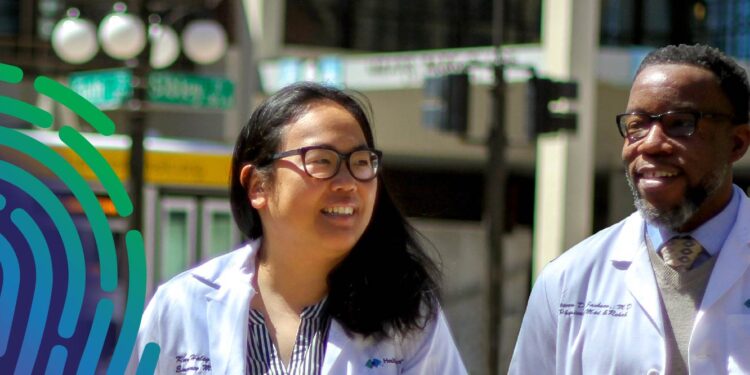“Hey, it’s Josh.”
When City of St. Paul paramedic-firefighter Josh Garubanda responded to a latest 911 name, he acknowledged the person with a major bodily damage as somebody he grew up with. “When they saw me,” Josh recounts, “and I [said], ‘Hey, it’s Josh,’ … they snapped out of their pain for a moment, to be like, ‘Oh, hey Josh’ … he’s like ‘I just knew at that point I’ll be fine’ in the long term. I’ll take care of him.”
Having a neighborhood’s variety mirrored in its emergency medical companies (EMS) and firefighting departments gives a important diploma of understanding, empathy and consolation throughout main occasions of disaster. However, main obstacles, cultural and in any other case, can maintain women and folks of shade again from pursuing a profession in these fields. Fortunately, EMS academies in St. Paul and Minneapolis are serving to make these alternatives extra accessible at a time the place there’s a huge paramedic and emergency medical technician (EMT) scarcity.
In right this moment’s episode of Off the Charts, Josh and fellow paramedic Nela Kurtic speak about how they got here up via St. Paul’s Pathways Program (now EMS Academy), their on-the-job experiences and challenges, the significance of getting neighborhood members as first responders and why seeing folks like them in these positions is so inspiring. Listen to the episode or read the transcript.
The pathway to right this moment’s St. Paul EMS Academy
Josh and Nela have a number of years of expertise: Nela is in her eighth 12 months as a paramedic, at present a neighborhood paramedic for Regions Hospital having spent the final seven years working pre-hospital for a hospital-based system. And earlier than Josh joined town of St. Paul a couple of years in the past, he was as a paramedic for a personal service.
Both started their present careers via town of St. Paul’s Pathways Program, now often called the St. Paul Fire Department’s EMS Academy. Similar to different pipeline packages nationwide (together with Minneapolis), the EMS Academy is directed towards low-income communities, folks of shade, immigrants and women dwelling in or close to St. Paul and in search of a brand new profession. Now in its 15th year and 21st class, candidates in the tuition-free program obtain paid training in EMS expertise. At the tip of the 12-week program, graduates earn their National EMT certification.
As early graduates, each Josh and Nela have seen this system’s content material evolve from a single course right into a complete curriculum that features essential work expertise and connections to present profession alternatives. Today, the EMS Academy helps to fill the scarcity of paramedics and EMTs with certified and various graduates that higher mirror the communities they serve.
Tackling cultural and medical obstacles
While the EMS Academy does an excellent job of making ready various candidates for the sector, there are nonetheless loads of cultural obstacles that stay as soon as they start answering calls as paramedics. When Nela started her medical expertise and ambulance ride-alongs as a part of her training, she was the one lady regardless of being a part of a various academy class. And whereas right this moment’s EMS departments have a extra even gender cut up, they’re nonetheless primarily white – very like the world’s firefighting departments.
That lack of variety, paired with having to navigate present cultural nuances in an already extraordinarily disturbing job, gives main obstacles to entry for women and folks of shade. And even once they enter the sector, the twin stressors of the job itself together with the isolation of navigating a homogeneous work surroundings could be too exhausting for some graduates to remain.
That’s why the neighborhood, connections and mentorships created by the EMS Academy are so essential. By staying in contact, academy graduates previous and present may also help navigate the conversations and conditions that may come up throughout shifts, sharing methods and information on all the pieces from nurse studies to on-the-job interactions.
As Nela discusses through the podcast, it’s good to name somebody and ask a second opinion about your working analysis or in case you selected the suitable medicines, or to textual content somebody in your neighborhood to get and give recommendation. By having open traces of communication via a community of sources, everybody that’s related has what they should turn into higher paramedics and to obtain the assist they want.
The aid and inspiration of neighborhood reflection
While the EMS profession path for women and folks of shade isn’t straightforward, it’s additionally tremendously fulfilling and community-critical. As Josh says through the podcast. “I’m very fortunate and I feel very blessed to be able to work in the city that I grep up in … I feel like it’s a privilege to be able to help take care of people that are my friends’ family members … to help be a liaison in that moment of pain and uncertainty. I’ve heard that there’s a sigh of relief because they knew [that when we] close those ambulance doors, there’s someone in the back there that’s going to look out for them.”
It’s additionally particularly essential for immigrant neighborhood members to know that they’re being heard and revered throughout unfamiliar occasions of disaster. By having familiarity with particular customs, household buildings, communication types and decision-making approaches, community-based paramedics and firefighters can ship a singular diploma of empathy and understanding that brings environment friendly and compassionate care to these in want.
But illustration can be essential for increasing the horizons of younger women and folks of shade. As podcast co-host Dr. Jackson says usually, “you can’t be what you can’t see.” Josh didn’t see any Black firefighters rising up, not realizing it was even an choice earlier than assembly a Black firefighting crew in Colorado. Being capable of see and hear from folks like him in these positions helped to create that entry and make it a actuality for himself. And now with 317 graduates and counting, the St. Paul EMS Academy can be making that path actual in neighborhoods throughout town and surrounding suburbs.
To hear extra from Josh and Nela, together with their early experiences as paramedics, the position of mentorship in stopping awkward conditions and how asking the suitable questions empowers the folks they serve on calls, take heed to this episode of Off the Charts.


















Discussion about this post